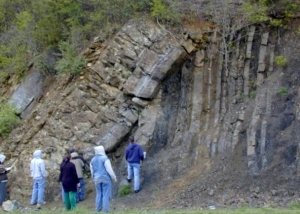The Austin Glen Formation.
On the Rocks – The Woodstock Times 1998
Updated by Robert and Johanna Titus
The east side of the Hudson River has some very different rocks from those we see around Woodstock. They’re older too and so, of course, they must have different stories to tell. Cross over the Kingston-Rhinecliff Bridge and you won’t have to go far before you see some of these strata. On the north side of the highway (Rt. 199) We found a nice road cut. It was a sequence of dark, thin-bedded shales interbedded with many thick strata of brown and gray sandstone. You are likely to have passed this outcrop many times without taking note of it and we don’t blame you. The unit of rock here is called the Austin Glen Formation and it is certainly not much to look at, gray sandstone alternating with dark shale is hardly picturesque. But to appreciate a unit of rock you have to really understand it and, dull as it looks, the Austin Glen is a most remarkable sequence of strata.
 Austin Glen to the right.
Austin Glen to the right.
There are problems with the unit which, when solved, lead to a fine story. Let’s see. The black shales of the Austin Glen pose little trouble in understanding, or so it would seem. Black shales were once black mud. Such mud accumulated on the quiet floor of a deep ocean and I mean really deep, maybe tens of thousands of feet, a real abyss. So that’s that; the Austin Glen must have formed in the depths of one of the earth’s deepest oceans, or so the shales say. But the sandstones tell a different tale. The sandstones were deposited by fast-flowing currents. we looked and found laminations that are typical of such conditions. And there were also ripple marks preserved in the sands, these are the sculptures of powerful currents. Such currents are most often found in shallow waters. So, the Austin Glen must have formed in a shallow sea, or so the sands say.
So, which is it? Are the shales correct in their tale of deep, quiet waters or are the sandstones closer to the mark? Who’s telling the truth and who is trying to fool us? This is the sort of problem geologists frequently face. Fortunately, this problem had already been solved. Our interpretation of the shales was probably okay, but we must confess that we did get the sands all wrong, at least at first telling.
The sandstone beds of the Austin Glen weren’t deposited by shallow water currents; they were gravity deposits, essentially submarine avalanches. The Austin Glen did indeed, as the shales said, accumulate in very deep, quiet seas. At least they were usually quiet and most of the time the soft muds settled to the bottom of this oceanic basin. But this sea floor was at the bottom of a steep and very deep marine slope. From time to time earthquakes occurred and these triggered the sudden downslope displacement of large amounts of sand, submarine avalanches. We call these “turbidity currents,” and their sandy deposits are called turbidites. Their rapid downward rush slowed near the bottom of the slope and then deposited the laminated and
sometimes rippled sands that we see today.
After each avalanche the sea returned to the slow piling up of more mud. Hence thicknesses of black shale were commonly punctuated by layers of sandstone. In the end the typical Austin Glen strata formed. All this took a very long time and a total of more than 500 feet of Austin Glen strata piled up.
That outcrop, east of the Rhinecliff Bridge, is thus a history, written in rock, of the hit and miss crustal activities of long ago. As we walked along the outcrop we sometimes saw thick sequences of shales; those were the long quiet periods between earthquakes and turbidity currents, when only muds accumulated. There were also a number of thin sandstones, they were turbidites of lessor magnitudes. But then there were also sequences of very thick turbidites laid down in quick succession. We thought about those times; they must have been difficult chapters in our local history, times when powerful earthquakes may have rocked the area, sending great turbidity currents plummeting into the abyss. These were remarkable times, but they would have been forgotten except that they were preserved in the roadside rocks.
Contact the authors at randjtitus@prodigy.net. Join their facebook page “The Catskill Geologist.





